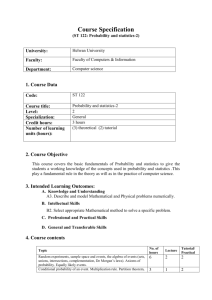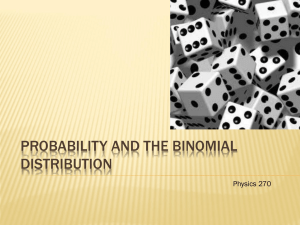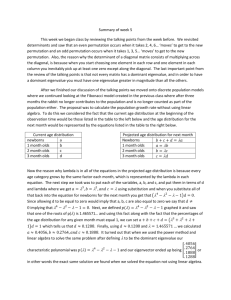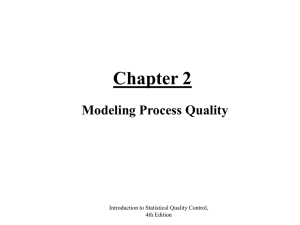ERS 488/688 Laboratory 3
advertisement
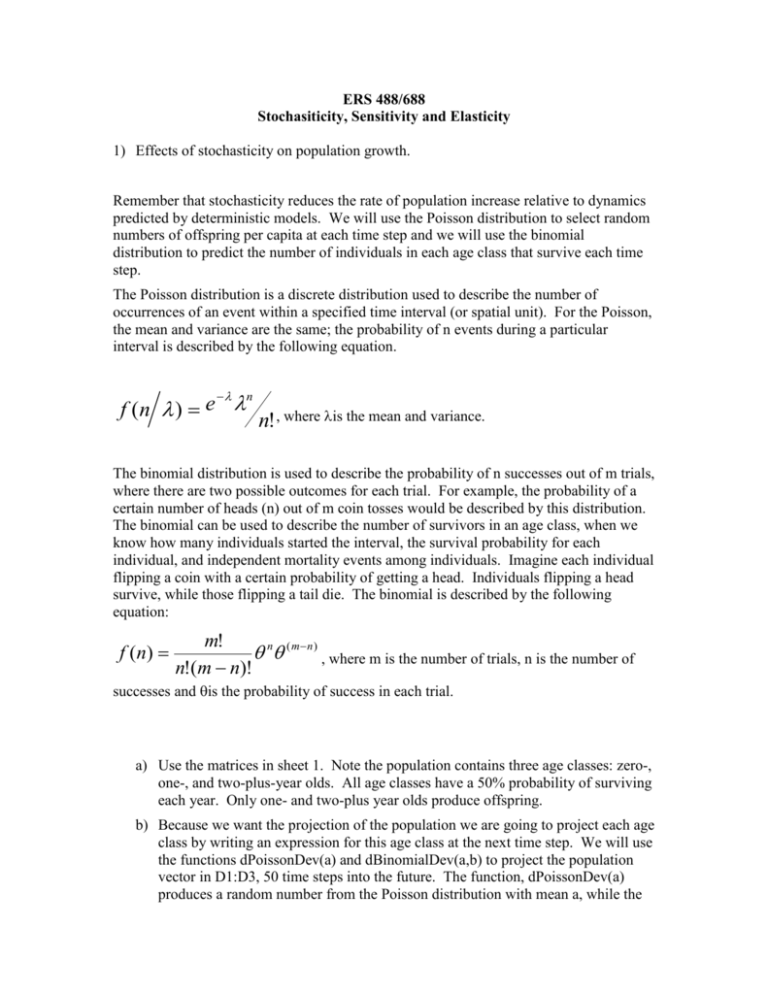
ERS 488/688 Stochasiticity, Sensitivity and Elasticity 1) Effects of stochasticity on population growth. Remember that stochasticity reduces the rate of population increase relative to dynamics predicted by deterministic models. We will use the Poisson distribution to select random numbers of offspring per capita at each time step and we will use the binomial distribution to predict the number of individuals in each age class that survive each time step. The Poisson distribution is a discrete distribution used to describe the number of occurrences of an event within a specified time interval (or spatial unit). For the Poisson, the mean and variance are the same; the probability of n events during a particular interval is described by the following equation. n f (n ) e n! , where is the mean and variance. The binomial distribution is used to describe the probability of n successes out of m trials, where there are two possible outcomes for each trial. For example, the probability of a certain number of heads (n) out of m coin tosses would be described by this distribution. The binomial can be used to describe the number of survivors in an age class, when we know how many individuals started the interval, the survival probability for each individual, and independent mortality events among individuals. Imagine each individual flipping a coin with a certain probability of getting a head. Individuals flipping a head survive, while those flipping a tail die. The binomial is described by the following equation: f ( n) m! n ( mn ) , where m is the number of trials, n is the number of n!(m n)! successes and is the probability of success in each trial. a) Use the matrices in sheet 1. Note the population contains three age classes: zero-, one-, and two-plus-year olds. All age classes have a 50% probability of surviving each year. Only one- and two-plus year olds produce offspring. b) Because we want the projection of the population we are going to project each age class by writing an expression for this age class at the next time step. We will use the functions dPoissonDev(a) and dBinomialDev(a,b) to project the population vector in D1:D3, 50 time steps into the future. The function, dPoissonDev(a) produces a random number from the Poisson distribution with mean a, while the function dBinomialDev(a,b) produces a binomial variate for a trials with probability b of success in each trial. The first produces random variation in births, while the second produces random variation in survival. The Poisson will provide a random number of per capita births at each time step. The Leslie matrix in A1:C3 tells us that one- and two-year old individuals are expected to produce two offspring each during each time step. Place a formula in E1 that will provide the correct number of newborns using the Poisson distribution and the expected number of offspring per capita. The number of one- and two-plus year olds depends on the number of one-year olds surviving to be two and the sum of the number of one and two-plus year olds surviving to be two-plus. Use the binomial random variable to project the number of one-year olds (cell E2) and the number of two-plus year olds (cell E3). To project the population place the curser in E1, left click the mouse and pull the curser down to E3. This selects population vector. Place the curser on the lower right corner of E3, left click and drag the mouse to the right until enough columns have been selected to account for 50 time steps. c) Calculate total population size and for each time step. Remember total population size is just the sume of the numbers in each age class. Use SUM(D1:D3) in D4 for the initial population size, then drag to the right to include all time steps. To calculate , remember = Nt+1/Nt. d) Use the AVERAGE, VAR, AND GEOMEAN functions to calculate mean and variance, and geometric mean values for . How do these compare to each other? Try the formula ln(geometric mean) = ln()-(2/22). Remember 2 is the variance. 2) Use the Leslie matrix for Tar on sheet 2. Remember that sensitivity of to a Leslie matrix element is defined as /aij. We can approximate sensitivity using /aij, where indicates a finite (but small) change in the parameter. a) Use manual procedures to compare sensitivity of to early fecundity (1st four years), midlife fecundity (2nd four years), late fecundity (last 5 years), early survival (first four years), and later survival (last nine years). Try 10% changes in the matrix elements for these calculations. I suggest you make a copy of the Leslie matrix and the initial population vector for each set of parameters for which you wish to estimate sensitivity. Remember matrix multiplication (MMULT is an array formula. Select the cells where the output vector will go, enter the formula MMULT(aij:bij,cij:dij), press F2, then Ctrl-Shift-Enter and the projected population vector will appear in the selected columns. Drag to the right to project the population for more time steps. Remember to project far enough so the population has reached a stable age distribution before comparing s b) Use the analysis feature (part of Matrix Tools) in Poptools to calculate , stable age distribution, reproductive values, and sensitivities for the Tar data. To get sensitivities use the array formula: SENSITIVITY (Aij:Bij), Where Aij and Bij define the upper left and lower right corners of the Leslie matrix. Remember how to apply an array formula. The elements of the new matrix are the sensitivities of to the specific element of the Leslie matrix. c) Use the formula s ij vi w j w, v to check estimates of sensitivity provided by Poptools. Remember, w, v is the transpose of v multiplied by w. Remember v is the vector of reproductive values and w is the stable age distribution vector.


